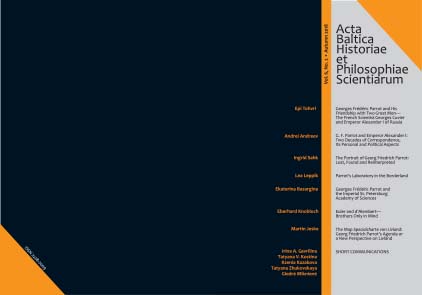Parrot’s Laboratory in the Borderland
Parrot’s Laboratory in the Borderland
Author(s): Lea LeppikSubject(s): History of ideas, 19th Century
Published by: Tallinna Tehnikaülikooli õiguse instituut
Keywords: Enlightenment; history of physics and chemistry; Parrot; University of Tartu;
Summary/Abstract: Georg Friedrich Parrot, professor of physics at the University of Tartu/Dorpat from 1802 until 1826, founded the best physics laboratory in the Russian Empire, containing ca. 450 experimental devices of which more than 60 had been invented by Parrot himself. Of the total number of instruments approximately 50 are still preserved in the University of Tartu Museum collections. The article is the first attempt to give a historical background of the laboratory, using Parrot’s own writings, archival sources and the extant devices. Parrot’s youth was shaped by the ideas of the French Enlightenment. According to his worldview, education had to be practical, utilitarian, and based on natural sciences. A well-equipped laboratory was ineluctable for that. Lavoisier’s chemistry was taught at the University of Tartu since the very beginning. Parrot emerged as one of the first French mathematical physics in a German-speaking world and introduced a new branch of physics—the physics of the Earth. His pioneering chemical theory of galvanic electricity failed to gain him recognition in his lifetime, but it shaped the worldview of later students. Parrot’s organisational talent took both the laboratory and the teaching in Tartu to the highest level of the time. His textbooks helped to introduce the physics worldview to the next generation both on the secondary school and university level.
Journal: Acta Baltica Historiae et Philosophiae Scientiarum
- Issue Year: 6/2018
- Issue No: 2
- Page Range: 66-84
- Page Count: 19
- Language: English

